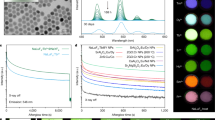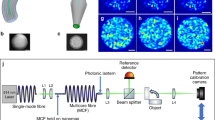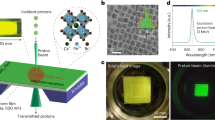Abstract
Luminescence intensity in photodetectors, radiation imagers and light-emitting diodes is proportional to the thickness of the light-emitting layer. However, a thick emitting layer reduces light output because of incoherent photon scattering and attenuation. Here we present the design of double-tapered optical-fibre arrays that can drastically increase the light output of thick light-emitting layers by progressively filling more propagation modes along the fibre’s depth. To enhance the light-collection efficiency and imaging resolution, the upper taper angle of each fibre is greater than the lower angle. By filling the fibre substrate with perovskite nanocrystals from a scale of micrometres thick to centimetres thick, large-scale pixel-dense X-ray or gamma-ray detector arrays can be fabricated. We demonstrate X-ray imaging with a spatial resolution of 22 lp mm−1. Pixelated gamma-ray imaging is also demonstrated using a nanocrystal scintillator film with a thickness of 4 mm and ~10,000 pixels under focused 6-MeV irradiation. Dynamic changes in the energy spectrum (5 keV to 10 MeV) and dose rate (3.5 nGy s−1 to 96 mGy s−1) can be conveniently monitored using a hemispherical fibre array dosimeter with a field of view of 150°. This study presents a high-throughput approach for fabricating thick emitter layers that could be applied to biomolecular or mechanical force sensing, medical imaging and ion beam therapy.
This is a preview of subscription content, access via your institution
Access options
Access Nature and 54 other Nature Portfolio journals
Get Nature+, our best-value online-access subscription
$29.99 / 30 days
cancel any time
Subscribe to this journal
Receive 12 print issues and online access
$209.00 per year
only $17.42 per issue
Buy this article
- Purchase on Springer Link
- Instant access to full article PDF
Prices may be subject to local taxes which are calculated during checkout





Similar content being viewed by others
Data availability
The data that support the findings of this study are available from the corresponding authors upon reasonable request.
Code availability
The codes are available from the corresponding authors upon reasonable request.
References
Yakunin, S. et al. Detection of gamma photons using solution-grown single crystals of hybrid lead halide perovskites. Nat. Photon. 10, 585–589 (2016).
Cao, Z. et al. Ultrahigh-energy photons up to 1.4 petaelectronvolts from 12 γ-ray galactic sources. Nature 594, 33–36 (2021).
Kataoka, J. et al. Recent progress of MPPC-based scintillation detectors in high precision X-ray and γ-ray imaging. Nucl. Instrum. Methods Phys. Res. A 784, 248–254 (2015).
Franks, L. et al. Hard X-Ray, Gamma-Ray and Neutron Detector Physics XVII Vol. 9593 (SPIE, 2015).
Oshima, T. et al. Development of a high-precision color γ-ray image sensor based on TSV-MPPC and diced scintillator arrays. Nucl. Instrum. Methods Phys. Res. A 803, 8–14 (2015).
Roques-Carmes, C. et al. A framework for scintillation in nanophotonics. Science 375, eabm9293 (2022).
Kim, Y. C. et al. Printable organometallic perovskite enables large-area, low-dose X-ray imaging. Nature 550, 87–91 (2017).
Zhao, J. et al. Perovskite-filled membranes for flexible and large-area direct-conversion X-ray detector arrays. Nat. Photon. 14, 612–617 (2020).
Gao, Y. et al. Ultrathin and ultrasensitive direct X-ray detector based on heterojunction phototransistors. Adv. Mater. 33, e2101717 (2021).
Zhuang, R. et al. Highly sensitive X-ray detector made of layered perovskite-like (NH4)3Bi2I9 single crystal with anisotropic response. Nat. Photon. 13, 602–608 (2019).
Heo, J. H. et al. High-performance next-generation perovskite nanocrystal scintillator for nondestructive X-ray imaging. Adv. Mater. 30, e1801743 (2018).
Pan, W. et al. Cs2AgBiBr6 single-crystal X-ray detectors with a low detection limit. Nat. Photon. 11, 726–732 (2017).
Shrestha, S. et al. High-performance direct conversion X-ray detectors based on sintered hybrid lead triiodide perovskite wafers. Nat. Photon. 11, 436–440 (2017).
Wei, H. et al. Sensitive X-ray detectors made of methylammonium lead tribromide perovskite single crystals. Nat. Photon. 10, 333–339 (2016).
Deumel, S. et al. High-sensitivity high-resolution X-ray imaging with soft-sintered metal halide perovskites. Nat. Electron. 4, 681–688 (2021).
Wei, H. et al. Dopant compensation in alloyed CH3NH3PbBr3 − xClx perovskite single crystals for γ-ray spectroscopy. Nat. Mater. 16, 826–833 (2017).
He, Y. et al. CsPbBr3 perovskite detectors with 1.4% energy resolution for high-energy γ-rays. Nat. Photon. 15, 36–42 (2020).
He, Y. et al. High spectral resolution of γ-rays at room temperature by perovskite CsPbBr3 single crystals. Nat. Commun. 9, 1609 (2018).
Chen, Q. et al. All-inorganic perovskite nanocrystal scintillators. Nature 561, 88–93 (2018).
Büchele, P. et al. X-ray imaging with scintillator-sensitized hybrid organic photodetectors. Nat. Photon. 9, 843–848 (2015).
Basirico, L. et al. Direct X-ray photoconversion in flexible organic thin film devices operated below 1 V. Nat. Commun. 7, 13063 (2016).
Ciavatti, A. et al. Toward low-voltage and bendable X-ray direct detectors based on organic semiconducting single crystals. Adv. Mater. 27, 7213–7220 (2015).
Liu, X. et al. Solution-grown formamidinium hybrid perovskite (FAPbBr3) single crystals for α-particle and γ-ray detection at room temperature. ACS Appl. Mater. Interfaces 13, 15383–15390 (2021).
Mills, C. A. et al. Direct detection of 6-MV X-rays from a medical linear accelerator using a semiconducting polymer diode. Phys. Med. Biol. 58, 4471–4482 (2013).
Loke, G. et al. Digital electronics in fibres enable fabric-based machine-learning inference. Nat. Commun. 12, 3317 (2021).
Brodnik, G. M. et al. Optically synchronized fibre links using spectrally pure chip-scale lasers. Nat. Photon. 15, 588–593 (2021).
Kanik, M. et al. Strain-programmable fiber-based artificial muscle. Science 365, 145–150 (2019).
Rein, M. et al. Diode fibres for fabric-based optical communications. Nature 560, 214–218 (2018).
Canales, A. et al. Multifunctional fibers for simultaneous optical, electrical and chemical interrogation of neural circuits in vivo. Nat. Biotechnol. 33, 277–284 (2015).
Korposh, S. et al. Tapered optical fibre sensors: current trends and future perspectives. Sensors 19, 2294 (2019).
Stranks, S. D. et al. The physics of light emission in halide perovskite devices. Adv. Mater. 31, e1803336 (2019).
Cho, C. et al. The role of photon recycling in perovskite light-emitting diodes. Nat. Commun. 11, 611 (2020).
Pisano, F. et al. Depth-resolved fiber photometry with a single tapered optical fiber implant. Nat. Methods 16, 1185–1192 (2019).
Pisanello, F. et al. Dynamic illumination of spatially restricted or large brain volumes via a single tapered optical fiber. Nat. Neurosci. 20, 1180–1188 (2017).
Pazos-Outón, L. M. et al. Photon recycling in lead iodide perovskite solar cells. Science 351, 1430–1433 (2016).
Dong, Q. et al. Electron-hole diffusion lengths > 175 μm in solution-grown CH3NH3PbI3 single crystals. Science 347, 967–970 (2015).
Fassl, P. et al. Revealing the internal luminescence quantum efficiency of perovskite films via accurate quantification of photon recycling. Matter 4, 1391–1412 (2021).
Richter, J. M. et al. Enhancing photoluminescence yields in lead halide perovskites by photon recycling and light out-coupling. Nat. Commun. 7, 13941 (2016).
Yu, H., Chen, T., Han, Z., Fan, J. & Pei, Q. Liquid scintillators loaded with up to 40 weight percent cesium lead bromide quantum dots for gamma scintillation. ACS Appl. Nano Mater. 5, 14572–14581 (2022).
Pan, L., Shrestha, S., Taylor, N., Nie, W. & Cao, L. R. Determination of X-ray detection limit and applications in perovskite X-ray detectors. Nat. Commun. 12, 5258 (2021).
Zaffalon, M. L. et al. Extreme γ-ray radiation hardness and high scintillation yield in perovskite nanocrystals. Nat. Photon. 16, 860–868 (2022).
Adams, R. & Zboray, R. Gamma radiography and tomography with a CCD camera and Co-60 source. Appl. Radiat. Isot. 127, 82–86 (2017).
Jones, E. A., Phan, T. D., Blanchard, D. A. & Miley, A. Breast-specific γ-imaging: molecular imaging of the breast using 99mTc-sestamibi and a small-field-of-view γ-camera. J. Nucl. Med. Technol. 37, 201–205 (2009).
Gu, L. et al. A biomimetic eye with a hemispherical perovskite nanowire array retina. Nature 581, 278–282 (2020).
Song, Y. M. et al. Digital cameras with designs inspired by the arthropod eye. Nature 497, 95–99 (2013).
Faber, D. J. et al. Oxygen saturation-dependent absorption and scattering of blood. Phys. Rev. Lett. 93, 028102 (2004).
Acknowledgements
This work was supported by the NUS NANONASH Program (NUHSRO/2020/002/413 NanoNash/LOA; R143000B43114) and National Research Foundation, Prime 225 Minister’s Office, Singapore under its Competitive Research Program (award no. NRF-CRP23-2019-0002) and under its NRF Investigatorship Programme (award no. NRF-NRFI05-2019-0003) and the RIE2025 Manufacturing, Trade and Connectivity (MTC) Programmatic Fund (award no. M21J9b0085).
Author information
Authors and Affiliations
Contributions
L.Y., B.H. and X.L. conceived and designed the project. X.L. supervised the project. H.Z. characterized the materials. L.Y. conducted the numerical simulations. B.H. performed device fabrication. B.H., L.Y. and H.Q.T. performed gamma-ray experiments. L.Y. and B.H. wrote the manuscript. X.L. edited the manuscript. All authors participated in the discussion and analysis of the manuscript.
Corresponding author
Ethics declarations
Competing interests
The authors declare no competing interests.
Peer review
Peer review information
Nature Photonics thanks Jiang Tang and the other, anonymous, reviewer(s) for their contribution to the peer review of this work.
Additional information
Publisher’s note Springer Nature remains neutral with regard to jurisdictional claims in published maps and institutional affiliations.
Supplementary information
Supplementary Information
Supplementary figs. 1–12 and table 1.
Supplementary Video 1
Comparison of pixel-dense gamma-ray imaging with and without double-tapered fibre array.
Rights and permissions
Springer Nature or its licensor (e.g. a society or other partner) holds exclusive rights to this article under a publishing agreement with the author(s) or other rightsholder(s); author self-archiving of the accepted manuscript version of this article is solely governed by the terms of such publishing agreement and applicable law.
About this article
Cite this article
Yi, L., Hou, B., Zhao, H. et al. A double-tapered fibre array for pixel-dense gamma-ray imaging. Nat. Photon. 17, 494–500 (2023). https://doi.org/10.1038/s41566-023-01204-1
Received:
Accepted:
Published:
Issue Date:
DOI: https://doi.org/10.1038/s41566-023-01204-1
This article is cited by
-
A detachable interface for stable low-voltage stretchable transistor arrays and high-resolution X-ray imaging
Nature Communications (2024)



